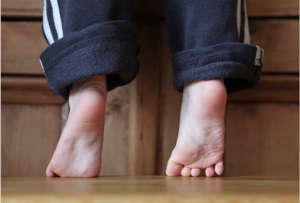
What is toe walking?
Toe walking can be described as walking on the toes or the balls of our feet without heel contact on the ground. It commonly can be described as your child always on their “tiptoes”. Some children with diagnoses such as cerebral palsy, muscular dystrophy, or autism may be seen walking on their toes. If a child is toe walking for an unknown cause, it can be described as idiopathic toe walking. Idiopathic toe walking is characterized by toe walking that is not occurring because of an underlying anatomical or neuromuscular cause. Factors that may play into idiopathic toe walking include;
Sensory-based factors causing toe walking can be seen due to hyposensitivity, hypersensitivity or sensory seeking.
- Hypo-sensitive reactions are represented as a child may toe walk for increased sensation input in their feet, as they seek increased weight through their toes or balls of their feet.
- Hyper-senstive children may be on their toes because they do not like the sensation of their entire foot contacting the ground and become overstimulated.
- Sensory seeking children may toe walk as they are seeking more input to their proprioceptive or vestibular system for a way to help regulate their sensory needs.
Musculoskeletal factors can also contribute to or be the result of a child toe walking. These can include;
- Tight calf or hamstring and hip musculature limiting the child to maintain a flat foot often occurring as a result of persistent toe walking
- Core, hip, and ankle weakness leading to compensation of toe walking to provide stability due to balance deficits
Should I be concerned or is this normal?
Toe walking can be seen in infants as a normal part of their development! When children begin to walk they may toe walk as a way of exploring their bodies and environment. Most children will mature from this toe walking pattern over time! Around the age of 2 years old, a child will begin to demonstrate a mature walking pattern with their heel making contact with the floor first. However, if you notice your child is walking >50% of the time on their toes and are over 2 years of age, a referral through a physical and/or occupational therapist may be recommended.
What can you do for your child?
If you are concerned about your child’s toe walking you can consult your pediatrician for a physical therapy evaluation. Physical therapists can complete a thorough examination to help understand your child’s toe walking and any other concerns such as strength and gross motor development. Treatments that we can provide include stretching of tight musculature, strengthening weak musculature, improving balance strategies, and promoting appropriate gross motor development. Sensory seeking, hyposensitive, and hypersensitive toe walkers should also be referred to an occupational therapist. Occupational therapists can provide strategies and support sensory needs that may be contributing to your child’s toe walking. Your child’s physical and/or occupational therapist together can create an individualized, holistic treatment plan just for your child!
You have the referral, but now what?
Here are some tips and tricks that you can utilize at home to help address your child’s toe walking!
- Standing with their toes on an elevated surface, such as a book or step, to stretch lower leg musculature, trying to hold with both legs straight up to 5 minutes. This can be done at a table or wall to help them keep their balance in this position.
- Standing on one leg for improved balance and ankle stability. You can modify standing on one leg by having your child stand with one foot on top of a book or ball.
- Animal walks: These are perfect to integrate into your daily routines! Have them walk like these animals down the hallway, to the bathroom, or on their way to another room in your home
- Penguin walks – walking on their heels to promote heel contact and ankle strength
- Bear walks – a fun active stretch of the lower leg musculature, walking forward with their hands and feet on the floor and stomach facing the ground
- Crab walks – for core and hip strengthening, walking on their hands and feet with their stomach facing the sky
Questions or concerns?
If you have questions or concerns about your child’s toe walking or gross motor development please contact us at info@playworkschicago.com or 773-332-9439.
Bridgett Hunziker, PT, DPT
Physical Therapist
References:
- https://www.hopkinsmedicine.org/health/conditions-and-diseases/toe-walking
- Morozova, O. M., Chang, T. F., & Brown, M. E. (2017). Toe Walking: When Do We Need to Worry?. Current problems in pediatric and adolescent health care, 47(7), 156–160. https://doi.org/10.1016/j.cppeds.2017.06.004
- Caserta, A. J., Pacey, V., Fahey, M., Gray, K., Engelbert, R. H., & Williams, C. M. (2019). Interventions for idiopathic toe walking. The Cochrane database of systematic reviews, 10(10), CD012363. Advance online publication. https://doi.org/10.1002/14651858.CD012363.pub2
- Ritchie-Persaud, PT, DPT, PCS, CKTP, L. (n.d.). A Distinctive Approach to Pediatric Toe Walking. Lecture. Retrieved from https://www.medbridgeeducation.com/player/course/6918198/4.
Photo Credit: dorioconnell via istockphoto.com
